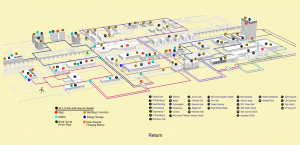He left school at the age of 15 to work at a plastics trading company. He worked 16 hours a day selling plastic watchbands, flowers and belts. Eventually, he saved up enough money to start his own plastics manufacturing firm. Today, he owns a 45,000-square-foot oceanfront mansion, a luxurious private plane and a Sunseeker yacht – the same model as the one featured in the James Bond film, Quantum of Solace. And at the ripe old age of 85, he’s still going strong. No wonder he’s known as “Superman” in Asia. And you’ll never guess where he’s investing right now …  Li Ka-Shing, Asia’s richest man and the world’s eighth wealthiest, with a net worth near US$31 billion. Over the last couple of months, he’s been busy selling some of his assets to raise cash to put to work in Europe. Ka-Shing is in the midst of a telecom buying spree. Since 2011, he has already purchased four European telecom companies for a total of US$4 billion. And he’s looking to do more. About a month ago, I told you Warren Buffett was also investing heavily in Europe. It seems the savviest investors and businessmen in the world are taking advantage of the bargains in Europe. You should be doing the same.
Li Ka-Shing, Asia’s richest man and the world’s eighth wealthiest, with a net worth near US$31 billion. Over the last couple of months, he’s been busy selling some of his assets to raise cash to put to work in Europe. Ka-Shing is in the midst of a telecom buying spree. Since 2011, he has already purchased four European telecom companies for a total of US$4 billion. And he’s looking to do more. About a month ago, I told you Warren Buffett was also investing heavily in Europe. It seems the savviest investors and businessmen in the world are taking advantage of the bargains in Europe. You should be doing the same.
IIT and the Smart Grid for Appliances
IIT is renowned for is technical leadership in many areas – particularly in the application of the smart grid for industrial, commercial and residential use. Its center of excellence located in the IITRI (Illinois Institute of Technology Research Institute) houses one of the most sophisticated centers of Smart Grid where world class companies like Schneider Electric, Emerson Electric, Littelfuse and other commercial conglomerates have invested in the university’s Smart Grid program. Leading edge innovative research is conducted around the troika of energy efficiency, sustainability and reliability.
Just recently IIT hosted the Great Lakes Smart Symposium on Smart Grid and The New Energy Economy led by Dr. Mohammad Shahidehpour, introduced new initiatives from local energy companies like Commonwealth Edison, Ameren Energy and S/C who help host new programs and educations seminars around the new economics of smarter energy. One of the key questions for many was how will the new energy economy create new jobs for the 21st century? Often the case for any new technology is can it pay for itself. As a leader in the smart energy arena, we can expect to grow new jobs through the re-education of resources, creation of new equipment, power plants, transmission support, computer applications, new maintenance services and really all related secondary services and products associated with the creation of a new industry.
A recent contribution from the resident appliance leader, Whirlpool, helped balance what was previously a more commercial and industrial focused smart grid. With the introduction of smart ranges, refrigerators, and microwaves for the residential area, the studies will help to enrich the everyday lives of citizens by offering the type of energy management enjoyed by the industrial and commercial companies. Consumers like us can expect higher performance appliances ease of use functionally, smarter energy management and control – even remote from that of a mobile device. You can start cooking from the comfort of your office.
Moneyball Style Marketing
In the book, Moneyball author Michael Lewis showed that there were a few statistics that answered key questions about an offensive player’s potential:
- On-base percentage: Can the batter get on base?
- Slugging percentage: Can the batter hit for power?
In our game, there are three primary numbers we care about. Below I’ll refer to “content elements” which can translate to concepts, ideas, keywords or a simple premise for your content marketing endeavors. This will help you focus and improve your content efforts, because every piece of content you create has an opportunity cost associated with it.
- Revenue: Does the content element speak to a service or product line that produces revenue?
- Search Volume: Is the audience actively searching for the content element?
- Social Chatter: Is the audience actively talking about the content element?
1. Revenue Potential
The first step is to determine what concepts actually relate to products and services that make your organization money. Take note of the common questions potential customers and influencers have about your offering(s). Establish a healthy number of questions as you will likely make some eliminations later in your analysis. Essentially, you are creating a list of inquiry prospects to run numbers against.
2. Search Potential
Once you have some concepts in mind based on the service/product lines that drive revenue and the common questions people have about each, you can begin to explore the search database. Tools like the Google Keyword Tool, Wordtracker and Keyword Discovery can help vet and validate content elements. Additionally, these tools mayshed light on terms and concepts with a wealth of search activity that you had not previously considered. The metric to be considered here is search volume (daily, weekly or monthly).
3. Social Potential
The final step is to determine the level of social chatter about each concept. Social monitoring and listening tools will unveil what content elements are prevalent in consumer dialogue and those that are largely invisible in social media. As for metrics, you may choose to collect number of mentions within blog posts, tweets, video hits and forum postings that include your content element or keyword. Using those specific measurements for a client, we combined totals for each source (blogs, twitter, video, forums) and created a “Social Sum” for each content element on our prospect list.
After you have collected your data, you can begin your analysis. Consider adding a scale to the varying degrees of revenue/profitability, search volume and social amplification (e.g. 1=low, 5=high). Carefully uncover those topics that meet the following requirements:
- This concept speaks to a service/product that makes us money
- This concept is highly searched
- This concept is discussed often
